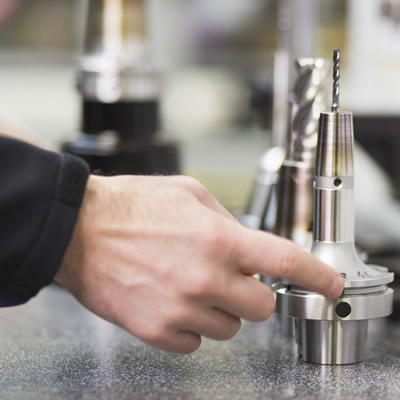
In 2016, Pilatus Aircraft Ltd. installed new manufacturing systems for machining structural parts made of aluminum. To achieve the desired surface quality and precision during high-speed milling operations, the aircraft manufacturer continuously relies on the solutions provided by Haimer: a large selection of toolholders and the corresponding shrinking and balancing machines.
Whenever someone in the precision machining industry talks about flying, one thing is typically brought up: chips. This also applies to Pilatus Aircraft Ltd. At its headquarters in Stans, Switzerland, everything generally revolves around the topic "flying," but machining structural parts also plays an important role. In 2016, Pilatus invested in a completely modernized volume-machining system to further improve the quality and efficiency of the production. Core elements of the enhanced production are two new flexible manufacturing systems that are run with full automation.
Walter Duss, director of milling, pointed out that fine-balanced tools are absolutely necessary: "Only the high balancing grade of the complete tool assembly, balanced on a Haimer balancing machine, together with Haimer toolholders can guarantee vibration-free machining and surfaces without any chatter marks. Furthermore, the high runout accuracy significantly increases the lifetime of the spindle and tools."
According to Patrik Odermatt, team leader mechanical processing and responsible for the internal division of tools at Pilatus, high-quality toolholders that offer long-term stability and runout accuracy definitely pay off. It is for this reason that he has been working with Haimer in Igenhausen for many years. He uses Haimer shrink-fit chucks and high-precision collet chucks together with the corresponding presetting, shrinking and balancing machines that are available at the Pilatus toolshop, which serves as their internal tool management service center.
"Regarding such topics as quality, price-performance ratio, consultation and support, our experience with Haimer is very positive," Odermatt explained. "That's why we made the decision to continuously and solely rely on toolholding
technology from Haimer when it comes to our new manufacturing system. We exclusively use tools that are clamped into Haimer standard shrink-fit chucks, ultrashort and long Power shrink chucks, as well as Power Mini shrink chucks, Power collet chucks and special facemill arbors.”
Since Pilatus is working with many different parts that are extremely thin with wall thicknesses ≤1.2 mm and deep pockets, the range of Haimer toolholders was an important consideration. Also Haimer has shown flexibility regarding the spindle interface. For the new manufacturing systems, a special HSK-A 63/80 toolholder was necessary. After close cooperation with Pilatus, Haimer developed a program for this interface and added it to its standard delivery portfolio.
Haimer also proves to be innovation-driven with its patent-pending mechanical locking Data-Lock system that fixes the RIFD data carrier onto the toolholder. Pilatus uses this solution to ensure that even at the highest rpm the data carriers are securely fixed and cannot separate from the toolholder.
According to tool expert Odermatt, one of the greatest advantages of working with Haimer is you can get all toolholding technology from a single source. “For every Haimer shrink-fit chuck, the required parameters are already integrated into the shrinking machines,” he said. “The performance and heating time are ideal and guarantee process-reliable shrinking at the push of a button. And balancing is also easy to perform.”
Related Glossary Terms
- chatter
chatter
Condition of vibration involving the machine, workpiece and cutting tool. Once this condition arises, it is often self-sustaining until the problem is corrected. Chatter can be identified when lines or grooves appear at regular intervals in the workpiece. These lines or grooves are caused by the teeth of the cutter as they vibrate in and out of the workpiece and their spacing depends on the frequency of vibration.
- chuck
chuck
Workholding device that affixes to a mill, lathe or drill-press spindle. It holds a tool or workpiece by one end, allowing it to be rotated. May also be fitted to the machine table to hold a workpiece. Two or more adjustable jaws actually hold the tool or part. May be actuated manually, pneumatically, hydraulically or electrically. See collet.
- collet
collet
Flexible-sided device that secures a tool or workpiece. Similar in function to a chuck, but can accommodate only a narrow size range. Typically provides greater gripping force and precision than a chuck. See chuck.
- facemill
facemill
Milling cutter for cutting flat surfaces.
- gang cutting ( milling)
gang cutting ( milling)
Machining with several cutters mounted on a single arbor, generally for simultaneous cutting.
- milling
milling
Machining operation in which metal or other material is removed by applying power to a rotating cutter. In vertical milling, the cutting tool is mounted vertically on the spindle. In horizontal milling, the cutting tool is mounted horizontally, either directly on the spindle or on an arbor. Horizontal milling is further broken down into conventional milling, where the cutter rotates opposite the direction of feed, or “up” into the workpiece; and climb milling, where the cutter rotates in the direction of feed, or “down” into the workpiece. Milling operations include plane or surface milling, endmilling, facemilling, angle milling, form milling and profiling.
- precision machining ( precision measurement)
precision machining ( precision measurement)
Machining and measuring to exacting standards. Four basic considerations are: dimensions, or geometrical characteristics such as lengths, angles and diameters of which the sizes are numerically specified; limits, or the maximum and minimum sizes permissible for a specified dimension; tolerances, or the total permissible variations in size; and allowances, or the prescribed differences in dimensions between mating parts.
- toolholder
toolholder
Secures a cutting tool during a machining operation. Basic types include block, cartridge, chuck, collet, fixed, modular, quick-change and rotating.
